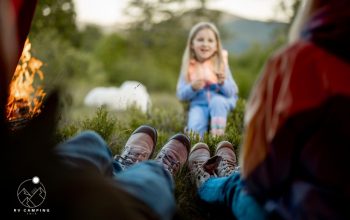Vacations are supposed to be a time of rest, but did you know that amidst the lush greenery and exotic flora, danger could be lurking? Poisonous plants are a hidden hazard that can cause severe skin irritation, rashes, and even blindness.
To ensure a safe and carefree getaway, it’s essential to be knowledgeable about these perils and take necessary precautions. In this blog, we delve into the complexities of identifying and avoiding these toxic terrors and equip you with the tools needed to protect yourself on your next adventure.
Learn To Recognize The Plants And Avoid Them
Protecting yourself and your loved ones from the harmful effects of noxious plants when camping requires a basic understanding of plant recognition. Familiarizing yourself with the appearance and characteristics of poisonous plants will go a long way in avoiding them during a camping trip.
However, this knowledge is only half the battle. It is also important to be keen on your surroundings and watch out for any suspicious-looking foliage. In addition to these preventative measures, it’s also a good idea to research the area you’ll be camping in and learn which plants are most commonly found there.
With this information, you’ll be able to take extra precautions and remain vigilant throughout your trip.
Wear Long Clothing-long, Pants, And Long Sleeves-when
Long clothing, such as pants and long sleeves, can protect harmful plants. This clothing helps shield the skin from accidental brush-ups with poisonous plants and minimizes the risk of exposure.
Furthermore, wearing long clothing can also serve as a visual reminder to be mindful of your surroundings, encouraging you to be more cautious and aware of potential dangers. So, next time you’re heading out on a camping trip, pack appropriate attire and protect yourself from harmful plants.
Use A Pre-contact Protective Lotion, Such As Büji Block
Pre-contact protection lotions like Büji Block make it easy to enjoy camping without worrying about harmful plants.
This ointment will protect you against the adverse effects of any flora you may come into contact with while camping. It’s reassuring to know your skin is protected and lessens the likelihood of rashes and other negative responses.
You should take a bottle of Büji Block with you on your next camping trip to ensure the safety of you and your loved ones.
Wash Your Hands After Touching Plants And Trees During Hiking
It’s also crucial to keep your hands clean while camping, especially after touching nature on a hike. It doesn’t take long to wash your hands with soap and water, but doing so can make a huge difference in preventing contact with poisonous plants.
Remember that many of these plants include oils and other hazardous compounds that may be transmitted readily to your skin. Make hand washing a regular part of your camping routine, and remember to include soap and water.
Keep Pets On A Leash
It is critical always to keep pets on a leash when camping with them. This not only keeps them from wandering into regions with toxic plants, but it also protects wildlife and other campers.
Pets are inherently inquisitive, and they may be drawn to plants with vivid or fragrant blossoms, unaware of the risk they bring. You can keep them safe and avoid touch with harmful plants by keeping them on a leash.
Whether hiking, exploring, or just resting at your campground, keeping your pets on a leash is a necessary safety precaution that should never be disregarded.

Research The Area
Before going on a camping vacation, it’s critical to do your homework and investigate the region where you’ll be camping. This involves determining which poisonous plants are present and what precautions you may take to protect yourself and your family from exposure.
To obtain as much knowledge as possible, use internet resources such as websites and forums specialized in outdoor activities. Consider chatting with a local specialist, such as a park ranger or a botanist, for guidance on risk reduction.
Use Anti-allergens
These medicines, which are often available in creams, sprays, and other topical therapies, can aid in the prevention of skin irritation, rashes, and other symptoms caused by harmful plant contact.
Bring enough anti-allergens with you on your camping vacation and use them often, especially if you intend to spend a lot of time outside or participate in activities that might increase your exposure.
Consider packing an emergency kit with antihistamines and other drugs in case of an allergic reaction.
Types Of Noxious Plants
Poison Ivy
This plant can grow as a vine or a shrub and is easily recognizable by its three leaves. Poison ivy releases an oil called urushiol which can cause an allergic reaction in humans.
It’s important to know that the oil can linger on clothing, tools, and other items for a long time, so it’s essential to take precautions when hiking or camping in areas where poison ivy is known to grow.
Oak
Oak trees are ubiquitous in many parts of the world and can often be found in wooded areas, parks, and backyards. While oak trees provide valuable shade and serve as a home for many types of wildlife, they can also be hazardous to humans.
Oak trees produce acorns which can be slippery and cause accidents, and their leaves and bark contain tannins that can cause skin irritation.
In addition, oak trees are a common source of allergies and can trigger symptoms such as sneezing, itching, and runny nose.
Sumac
Sumac is another type of noxious plant that can be found when camping or hiking. It grows as a shrub or a small tree and is recognizable by its red berries and leaves that turn bright red in the fall.
Sumac is a common allergen and can cause skin irritation and itching in some people. In addition, some species of sumac contain urushiol, the same oil found in poison ivy, and can cause an allergic reaction.
Be mindful of sumac outdoors, especially for those susceptible to skin irritations and allergies.
Conclusion
Protecting yourself and the people around you from harmful plants during a well-deserved vacation requires careful consideration of the surrounding environment and awareness of the potential dangers.
The key to staying protected is to be vigilant and informed while enjoying nature’s beauty and diversity. So, pack your bags and hit the road, but remember to do so with caution and an understanding of the perils posed by noxious plants.





